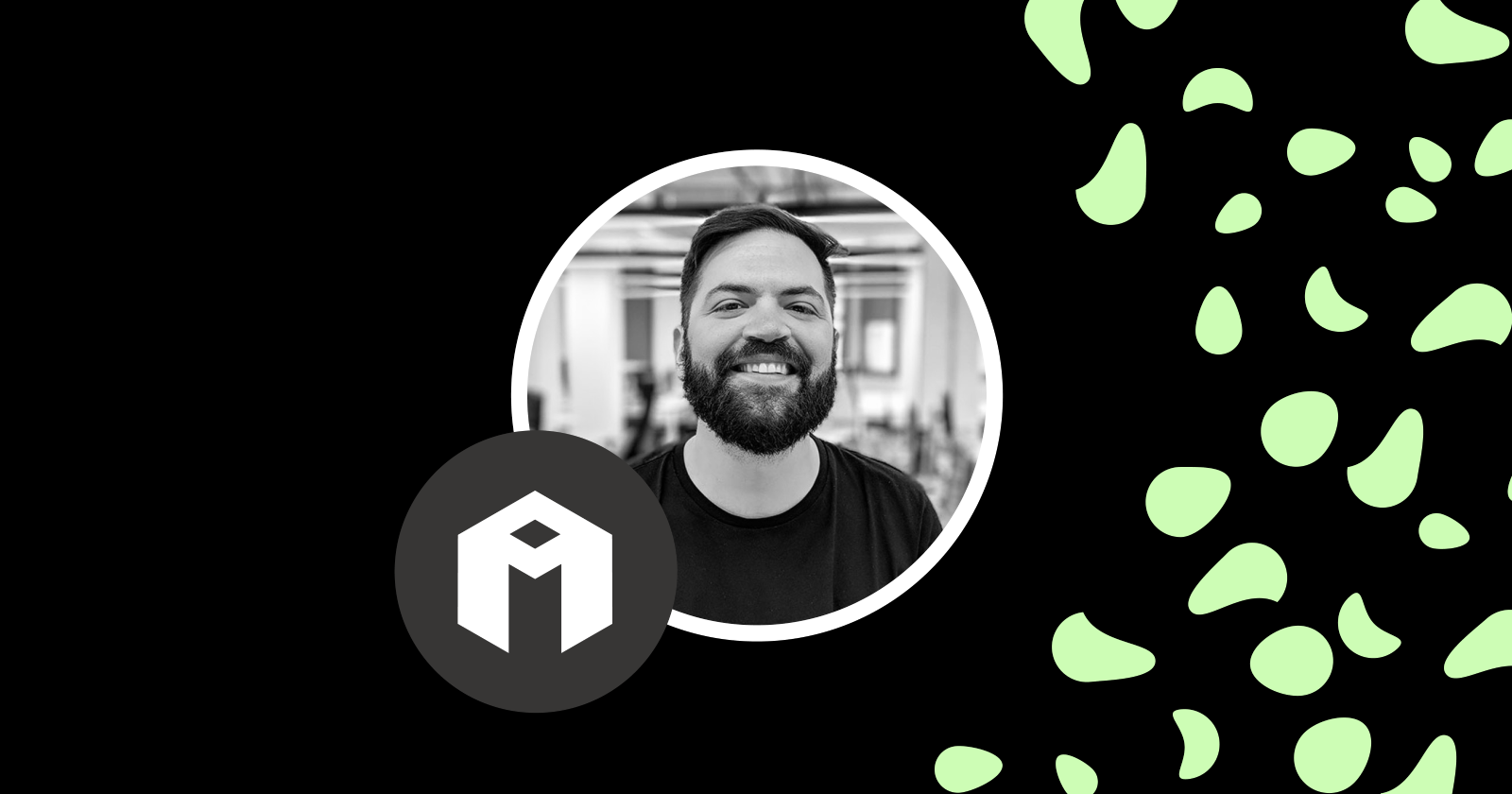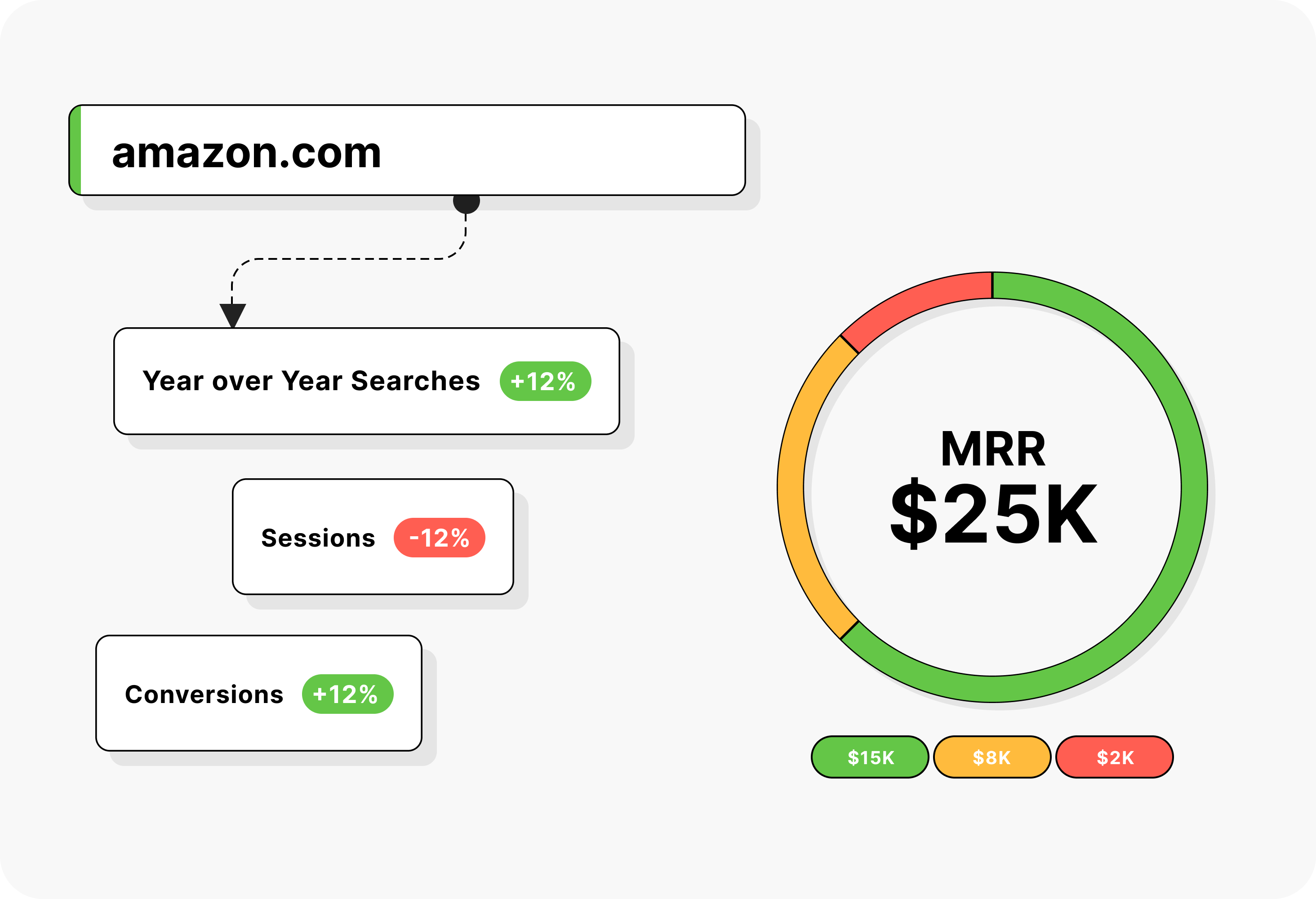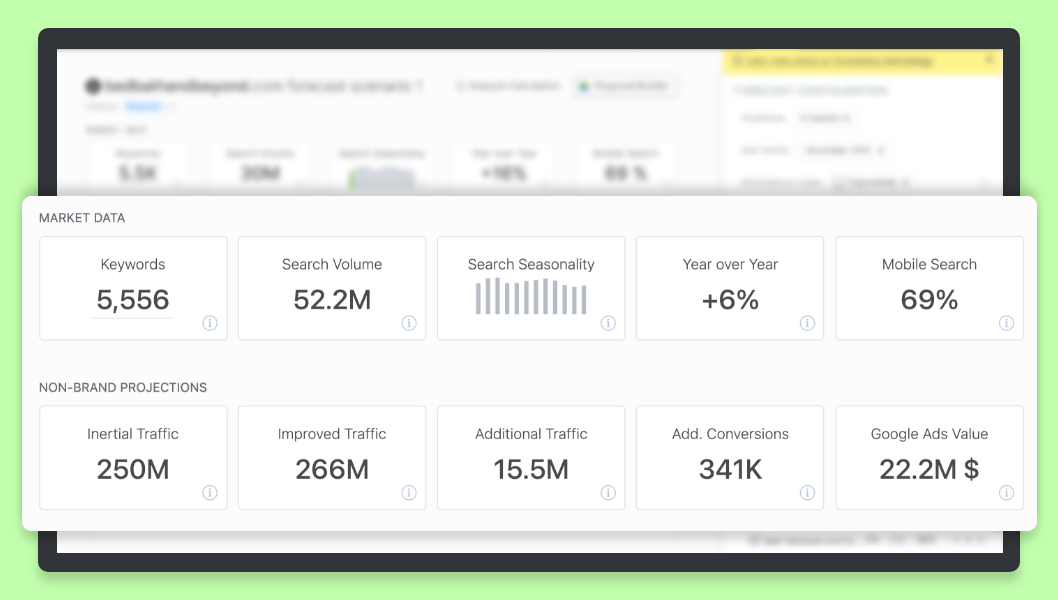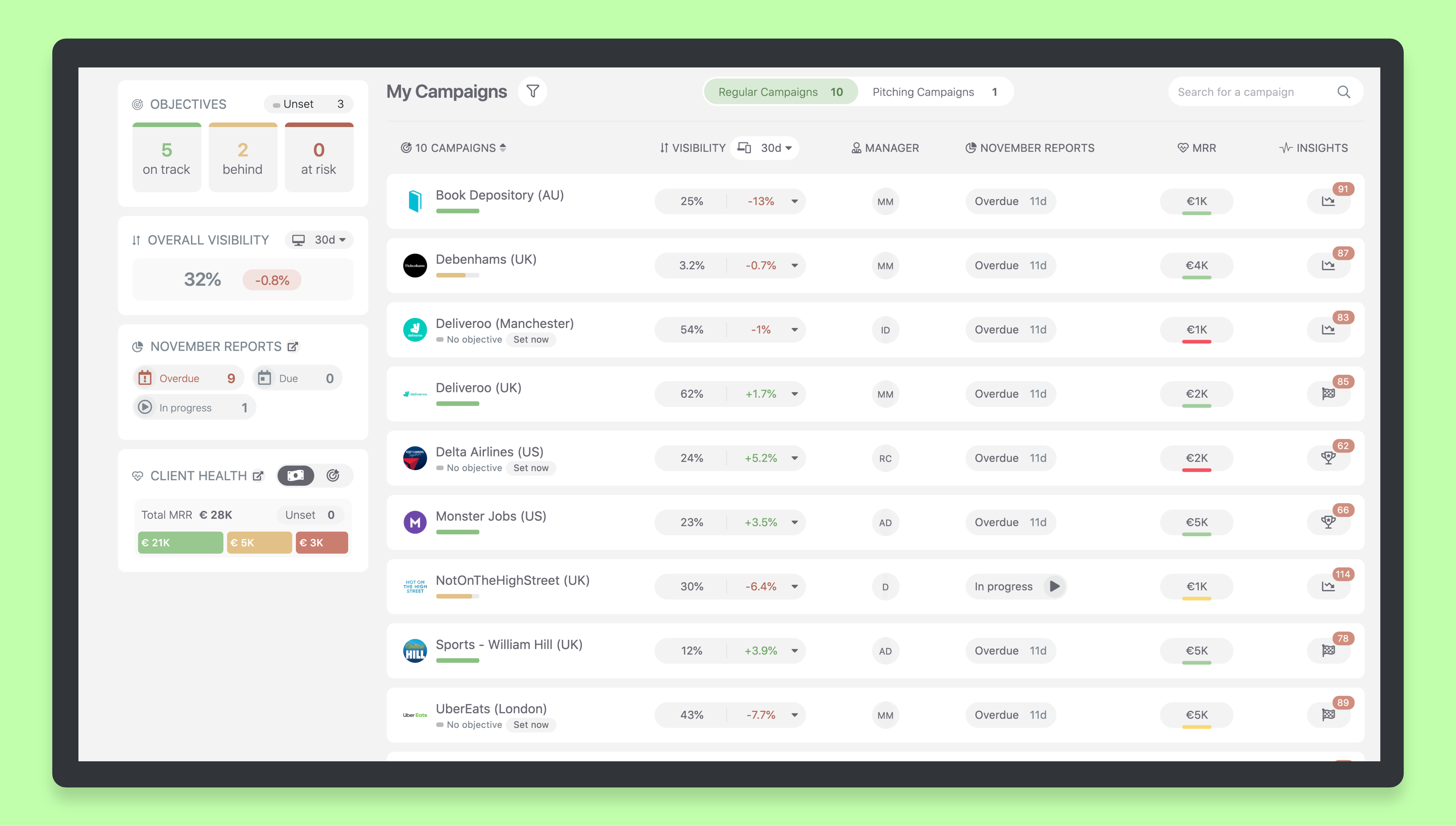The challenge of growing your SEO agency as the business gets more sophisticated boils down to two things:
- Acquiring clients.
- Keeping the churn rate low.
Even more important, behind those business chunks are your two main assets – people and time, the crucial unit economics you have as an agency, and tricky resources to measure.
Although everyone knows the old business adage that what doesn’t get measured, doesn’t get done, there is a lot of complexity to handle: new clients, current clients, project teams, departments, hours and revenue, etc.
And the harsh reality is that growth may come in bursts that can leave your agency understaffed or push your current team to burnout.
But an abstract, complex environment can be simplified with the right processes in place.
That’s why setting KPIs and creating operational flows to keep you accountable becomes a competitive advantage and a sure way to achieve those business targets for you and your clients:
- You’ll know how your qualifying process is actually faring.
- You’ll be able to assess the agency’s growth and future potential.
- You’ll know when it’s time to hire new people or refresh the tool stack.
To stay in control of your agency’s growth journey and know exactly what’s the next step, here are crucial points to consider, as seen from our in-depth talk with Petar Jovetic, Head of SEO at Impression.
Measure Your Client Portfolio Performance
The agency business model implies working with a retainer and maintaining clients satisfied so they don’t leave for another agency.
But what does retention translate to?
One way to look at it is in terms of the client’s business health:
- Sessions and conversions achieved due to your SEO efforts.
- Engagement metrics from each monthly reporting meeting.
- How the SEO objective looks (progress tracked) since the beginning of your collaboration.
Jovetic highlights the importance of developing a measurement plan for each client that is agreed upon from the beginning and evaluated against the set business and SEO objectives. This is part of a bigger client management process that Impression uses, which implies:
- A Brand & Channel strategic document that is “a living thing” and takes into account the client’s industry, targets, users, etc.
- Monthly reviews to track progress and adjust tactics if needed: looking at simple and efficient KPIs (CTRs, conversions, organic traffic growth, and, of course, revenue).
- Quarterly business reviews which offer the chance to review the initial 12 months roadmap and even discuss additional budget (depending on further growth opportunities and the speed of progress towards the objective timeframes set) – “There is a segment for creative thinking,” Jovetic adds, where the agency can get proactive with spotted opportunities.
Then, a simple and effective metric to evaluate is the monthly recurring revenue (MRR), tied to each client and tracked against their health. You need to be able to answer such questions as:
- Is their campaign on the right track?
- Is the SEO objective on track or at risk?
- How would their churn affect the agency’s revenue?
SEOmonitor’s agency dashboard allows you to segment your client portfolio by MRR and zoom into it at a campaign level, so you know which clients are in good, average, or bad health – a feature that Jovetic considers to support the consistency of monitoring and evaluating your agency’s KPIs.
Understand your overall portfolio performance and you will be able to control when it’s time to slow down on new business acquisitions and when it’s time to hire fast.
Align Client Acquisition & Growth Potential
If you have a good understanding of what your overall portfolio performance is, it will give you a clearer picture of what types of clients your agency wants or needs. You will also control when it’s time to slow down on new business acquisitions and when it’s time to hire fast.
For Impression, along with many other variables, it is retainer tiers from 1 to 5 that they developed for scaling purposes: focusing on tiers 1 to 3 at the moment, so big clients with compelling budgets or clients with fast growth and ambitious objectives.
Jovetic recalls one client in the FMCG industry that wanted to triple the annual turnover and needed an aggressive strategic mix for their digital presence, including search, paid, CRO, and digital PR. For the SEO side, they used a forecasting methodology that allowed them to calculate potential organic traffic growth and what that means in terms of conversion rates and revenue.
Then, they were able to create a 12-month roadmap and targets for each quarter, as their proof of concept was solid and referenced historic conversion rates, year-over-year search trends, device split, and even the long-tail effect. Upon completion, it was then fed into the wider digital forecast.
Another example was a large, international brand that had only 30% non-brand organic traffic, a short-lived history of SEO, and a conservative budget to work with.
Here is where Impression’s search team got creative with keyword grouping and topical tiers, zeroing in on specific landing pages and long-tail opportunities that would create a trustworthy narrative and a relevant ROI on both sides.
It was about recognizing what they could influence and what levers they could pull amongst the regular challenges of long development queues and limited internal and external resources.
Thus, using a reliable forecasting methodology will not only help you win new clients but also qualify them and assess their growth opportunities. Knowing when to say Yes and when to say No will help you in your scaling efforts.
Plus, you can take the Google Ads value equivalent of your forecasted SEO scenario and calculate your retainer accordingly, showcasing the business ROI and ensuring that you have an objective benchmark that the client can verify and trust.
For example, if it’s a client whose estimated Google Ads Value is $300,000 for the 12 months forecasted, then a monthly retainer of $1,500 is not far-fetched. Again, if it’s a client whose estimated growth almost equates to the retainer, then it’s probably not the right client for you.
With all these numbers crunched, you’ll have a clear picture of the potential MRR coming into your portfolio.
If it’s a client worth pursuing, another crucial fact is getting their buy-in. As Jovetic says, a forecast is as good as the alignment around it is – that’s why Impression adopted the owned and shared goals framework, setting shared goals both within agency departments and with the clients. These tie into the measurement plan, so no part of the monitoring process is forgotten and proper expectations are set from the start.
Having this acquisition framework in place ensures that only relevant clients with long-term potential enter the pipeline and the churn rate remains low.
Keep Track of Business Forecasts & Targets
Apart from the client overview, there is also the agency side that needs to be tracked and measured. Again, one simple and efficient metric here is a projected MRR – a target you set for your agency to achieve in terms of revenue by the end of the year.
Impression adopted the OKR (Objective and Key Results) framework to be able to treat themselves as a client and set targets at each level. As Jovetic explains, each department has quarterly targets and makes efforts to control attrition rates.
The leadership team uses an operational dashboard in the form of a Data Studio custom report which pulls data from all the important business parts: the time management software with tracked hours from each department, the HR system with individual objectives, the financial system with cash flows, and so on.
Having all the actionable metrics in one place allows them to do business forecasts for their agency and evaluate potential growth scenarios each quarter.
You don’t need to lose yourself in too many metrics and KPIs.
One to three key metrics to constantly monitor will do the trick, especially at the beginning of the process. After all, most are lagging indicators: “outputs” that can only be explained once the action is done like “client satisfaction.” You can evaluate client satisfaction once the quarter or the year is done and see the trend, but an actionable indicator, in this case, would be % of client goals reached.
For the SEO department, in particular, you can think about:
- The daily tasks that need real-time data.
- The historical trends you need to be aware of.
- The budgets and allocated resources per client.
SEOmonitor’s agency dashboard includes a daily snapshot of your client portfolio and main internal processes:
- The overall state of your SEO objectives.
- The Visibility trend across the portfolio.
- The MRR state across the portfolio and at an individual level.
- The monthly reports status across the agency and for each account manager.
- Key insights for each campaign that require your attention now – whether quick wins, campaign issues, competitor changes, etc.
To make sure you’re always in the know with important updates in your clients’ business health or campaigns, our platform sends alerts for each status change.
In a Nutshell
Every KPI set and operational dashboard created is only relevant if it’s actionable and “alive.” If you set it and forget it, then it won’t help you get the clarity you need.
For every step of the client’s journey, you can measure potential revenue, actual revenue, and room for growth. As an agency, you need to keep a fine balance between existing clients and new clients:
- Acquiring only the clients that are in for the long run and offer you a healthy ROI.
- Keeping the churn rate low by enabling internal processes from start to finish: client objectives, internal objectives, periodical reports, and business reviews.
That’s how you remain in control of your agency’s evolution and have the ability to start making projections on where you can be in a year or two.
SEOmonitor constantly optimizes the agency dashboard to accommodate the critical processes inside an agency – from campaign monitoring to report management and proposal building.
These features are part of our SEO platform designed just for agencies.
Join us in our quest to bring more transparency to the SEO industry.
Scale your agency
with a reliable SEO platform!
The opinions expressed in this article are the sponsor's own.






